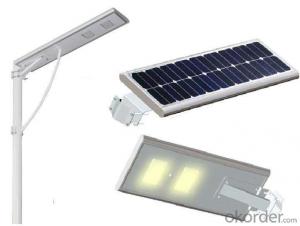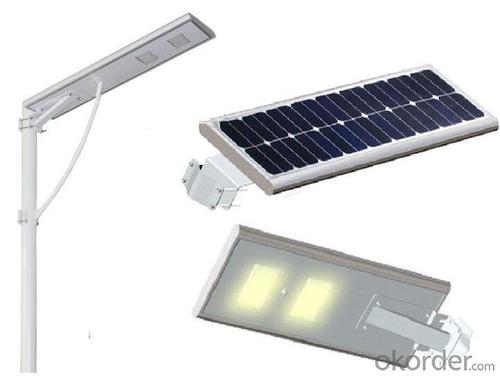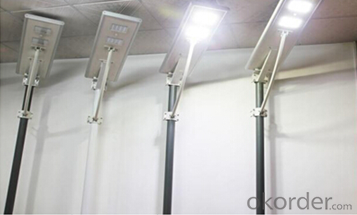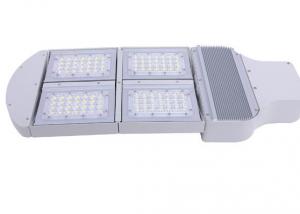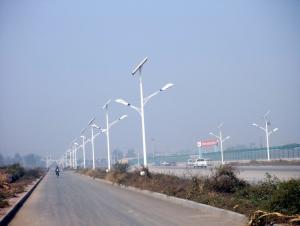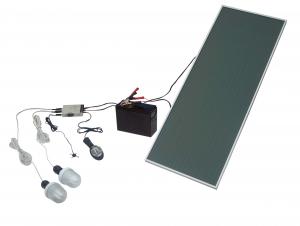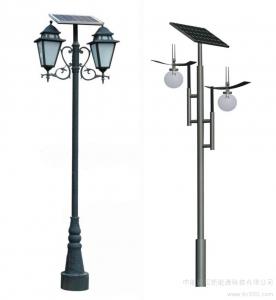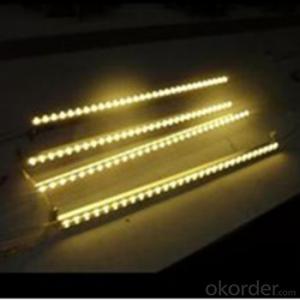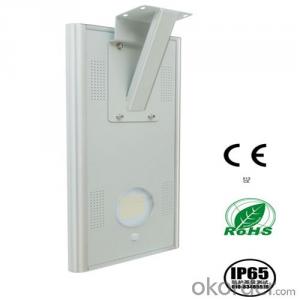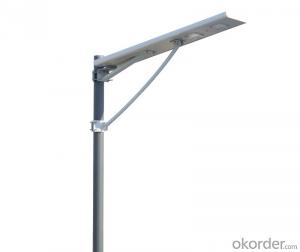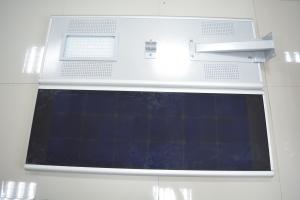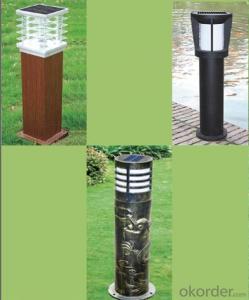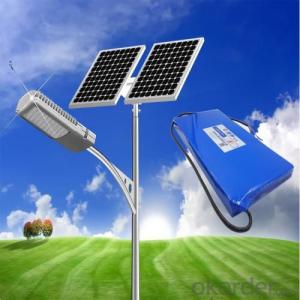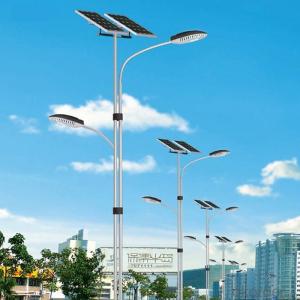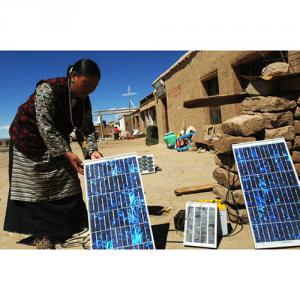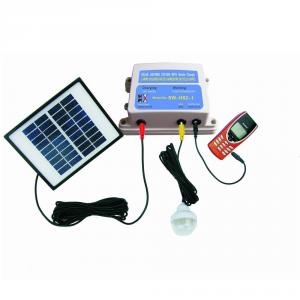All In One Solar Garden Light 60W with Mailbox Post Solar Light
- Loading Port:
- Shanghai
- Payment Terms:
- TT OR LC
- Min Order Qty:
- 1 pc
- Supply Capability:
- 1000 pc/month
OKorder Service Pledge
Quality Product, Order Online Tracking, Timely Delivery
OKorder Financial Service
Credit Rating, Credit Services, Credit Purchasing
You Might Also Like


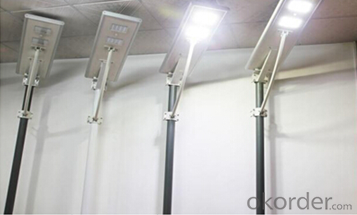

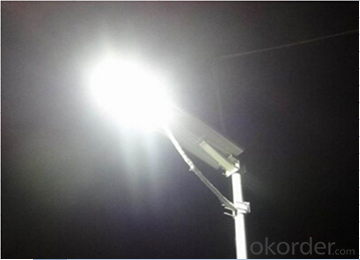
| 1. Discription: All in One Solar Garden Light | ||
| 2. Characteristics: 60W 7-9M High 6000-6600 LM | ||
| 3. Specification: | ||
| Solar panel | Power | 18V80W (American Sunpwer brand high efficiency mono-crystalline) | ||
| using life | 25 years | |||
| Battery | Model | lithium battery(12.8V/33AH Grade A mottcell Brand ) | ||
| Life span | 5 years | |||
| LED lamp | Power | 12V 60W | ||
| LED Brand | Bridgelux | |||
| Lumen(LM) | 6000-6600lm | |||
| LIfe span | 50000hrs | |||
| Light angle | 120° | |||
| charge time | Solar battery charging | 6hrs (Intense solar light charging) | ||
| Discharge time | full power | >15 hrs | ||
| Power saving mode | >30hrs | |||
| Working temperature | Unit( ℃ ) | -30℃~+70℃ | ||
| Color temperature | Unit(k) | 2700-7000k | ||
| Installation height | Unit(m) | 7 to 9 m | ||
| two light distance | Unit (m) | 25 to 30m | ||
| Lamp material | Aluminum Alloy | |||
| Certification | CE / ROHS / IP65 | |||
| Warranty | 2 years | |||
| Packing & weight | Product size | 1200*380*160mm | ||
| Product weight | 22kg | |||
| Packing carton | neutral | |||
| Packing size | 1230*460*230 mm | |||
| BOX | 1 set/box | |||
| Gross weight | 22.5kg | |||
| Container | 20'container | 280pcs | ||
| 40' container | 620pcs | |||
- Q: Are solar lights suitable for coastal areas?
- Yes, solar lights are suitable for coastal areas. They are designed to withstand harsh weather conditions, including high winds, salt spray, and humidity. Additionally, solar lights do not require any external power source, making them ideal for remote coastal locations where electricity may not be readily available.
- Q: Can solar lights be used for illuminating commercial signage?
- Yes, solar lights can be used for illuminating commercial signage. Solar lights are a cost-effective and energy-efficient option for illuminating signs in commercial settings. They harness solar energy during the day and store it in batteries, which can then power the lights at night. This eliminates the need for complex wiring and electricity consumption, making solar lights a convenient and sustainable choice for commercial signage illumination.
- Q: Are there solar lights for swimming pools?
- Yes, there are solar lights specifically designed for swimming pools. These lights are powered by solar energy and can be easily installed in or around the pool area to provide illumination during the night. They are a cost-effective and environmentally friendly option for pool lighting.
- Q: Do solar lights produce any heat?
- Yes, solar lights do produce a small amount of heat. However, the heat generated by solar lights is significantly lower compared to traditional incandescent or halogen lights.
- Q: Can solar lights be used in coastal areas?
- Yes, solar lights can be used in coastal areas. However, it is important to choose solar lights that are specifically designed for coastal environments, as they need to be able to withstand the harsh coastal conditions such as saltwater, high humidity, and strong winds.
- Q: Can solar lights be used for outdoor hotels or resorts?
- Yes, solar lights can be used for outdoor hotels or resorts. They are a sustainable and cost-effective lighting solution that can enhance the ambiance of outdoor spaces while reducing energy consumption. Solar lights can be installed in various outdoor areas such as pathways, gardens, pool areas, and patio spaces, providing illumination and creating a welcoming atmosphere for guests.
- Q: Solar lights do not always open but charge every day, the battery will be bad
- Open circuit voltage of about 4.5V, charge and discharge controller to detect this voltage after the action, the battery discharge to the lamp.
- Q: Are solar lights easy to maintain?
- Yes, solar lights are generally easy to maintain. They require minimal effort as they are powered by the sun, eliminating the need for complex wiring or replacing batteries. Regular cleaning of the solar panels to remove dust and debris is recommended for optimal performance. Additionally, occasional battery replacement may be necessary after several years of use. Overall, solar lights offer a hassle-free and cost-effective lighting solution.
- Q: Are solar lights compatible with rechargeable batteries?
- Yes, solar lights are compatible with rechargeable batteries. In fact, most solar lights are designed to be used with rechargeable batteries. These lights typically come with a built-in solar panel that charges the battery during the day using sunlight. The battery then powers the light during the night. Rechargeable batteries are preferred for solar lights as they can be charged and discharged multiple times, which makes them more cost-effective and environmentally friendly compared to disposable batteries. Additionally, rechargeable batteries have a longer lifespan and provide a consistent power source for solar lights.
- Q: Are solar lights suitable for road construction or work zone lighting?
- Yes, solar lights are suitable for road construction or work zone lighting. They are a cost-effective and environmentally friendly solution as they rely on solar energy to power the lights. Solar lights can be easily installed and relocated without the need for extensive wiring or electrical infrastructure. Additionally, they are designed to be durable and can withstand harsh weather conditions, making them ideal for outdoor use in road construction or work zones.
Send your message to us
All In One Solar Garden Light 60W with Mailbox Post Solar Light
- Loading Port:
- Shanghai
- Payment Terms:
- TT OR LC
- Min Order Qty:
- 1 pc
- Supply Capability:
- 1000 pc/month
OKorder Service Pledge
Quality Product, Order Online Tracking, Timely Delivery
OKorder Financial Service
Credit Rating, Credit Services, Credit Purchasing
Similar products
Hot products
Hot Searches
Related keywords
